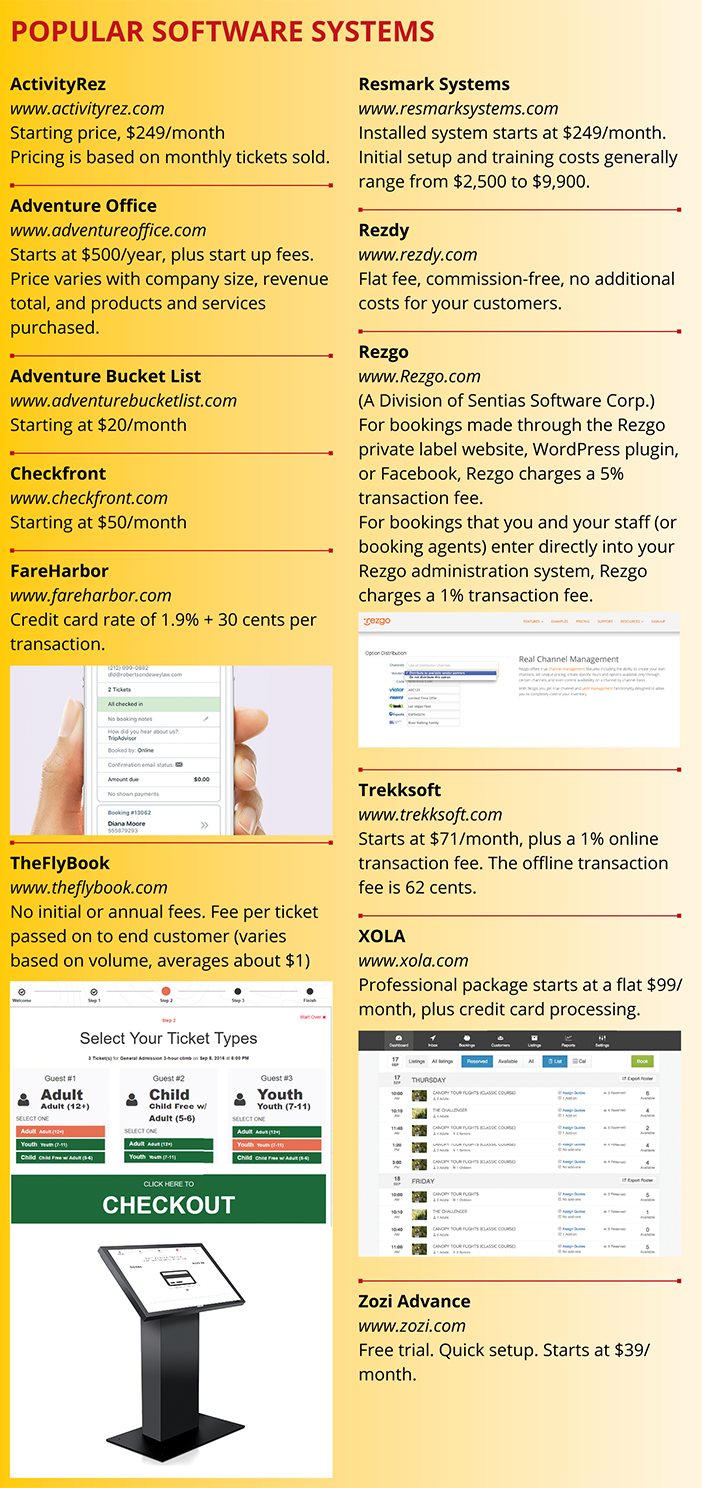Technology. It’s all around us. It might be in your pocket right now—or it might even be how you are reading this article. The advances in mobile technology have revolutionized the way we live and the way we do business. The world of travel and outdoor activities are no exceptions. Technology makes it possible for park staff to work from anywhere, and for your customers to make changes to their itineraries at 35,000 feet.
It’s safe to say that technology—especially booking technology—has impacted the aerial adventure industry. Technology has made it easier for consumers to plan, book, and manage travel. Yet, even with consumers pushing for last-minute and mobile-based options, there are still many adventure parks and zip tours operating in the “digital stone age, managing their bookings with sticky notes, desktop calendars, and three-ring binders,” says Craig Langer, president and CEO of TheFlyBook.
Don’t be that company. Digital technology is woven into every aspect of our modern existence, whether we’re sharing a selfie, ordering takeout, researching a destination for our next outing, or booking a zip tour adventure—and this trend is set to continue.
THE YEAR AHEAD
A decade ago, software to manage online bookings didn’t exist. Yet, within the past year, there has been a 50 percent increase in the number of booking software options. In 2017, businesses will have nowhere to hide from the disrupting, yet invigorating, effects of technology change. Those organizations with flexible processes, structures, and culture will be able to respond quickly, and will find technology-led changes loaded with opportunity. You can use this ever-changing environment to redefine your company, improve operations, create new revenue streams, and drive higher profits than ever before.
BOOKING SYSTEMS
How does the eye-watering next wave of technology support operators? And, how do you know you are using the best system for your organization? The opportunity to thrive is out there, and companies just need to be smart about how to tackle some of these changing trends in order to meet the needs of their organization and customers. Luckily, there are quite a few tools available online to help.
A quick search of Google for “how to choose a booking system” returns millions of articles with suggestions. Sure, many are written by the software companies themselves, but the articles still offer great insight into the knowledge and level of experience they bring to their customers. Of course, keep in mind that these may be written to tout some of their product’s best features.
If you are looking for an unbiased opinion, Liz Ward, one of the founders for an organization called Tourism Tribe, has created a series of tutorials for choosing a booking system. Many of which are free.
EMBRACE THE CLOUD
The aerial adventure industry is relatively new, which means vendors are able to create affordable platforms on the latest technology and systems, with no concern about compatibility with older, legacy software. Specifically, more vendors are offering the “software as a service” or Cloud-based model. This is beneficial, since the park operator using these systems does not need to worry about the hassle of maintaining software or hardware, and can instead focus on managing the business.
Current Cloud-based technology has been built to adapt to the changing demands of the travel and outdoor industries. With affordable applications available for both web and mobile, it has never been easier or more cost-effective to use a technology specifically designed for aerial adventure parks and zip line operations. That’s why more than 90 percent of vendors are currently using Cloud-based technology for their booking systems.
There is one major drawback, though. It’s the reason you will find “stability” at the top of any checklist for choosing a system. If a software company goes away, so does all of your sales and customer data. This was recently the case with Zerve. In a relatively short period of time, its 500+ clients had to decide what to do when Zerve shut down in the middle of busy summer bookings.
Ultimately, choosing a booking system is more than just making sure it has the typical features you’d expect, such as online booking capabilities, payment collection, staff scheduling, logistics planning, and low cost. It’s about whether you feel comfortable using it, and whether your staff will adopt it. Almost all booking software companies offer a free trial to help you dip your toe in the water before diving in, so take advantage of that.
Another important consideration is whether or not the company offers 24/7 support. If the company holds bankers’ hours and your busy time is the weekend, when an issue arises no one from the company will be there to answer the phone. It’s Murphy’s Law.
FIVE TRAVEL TECHNOLOGY TRENDS
Mobile First. This shouldn’t come as a surprise: More of us are now making travel plans on mobile devices. Thanks to wireless carriers lowering or eliminating their roaming charges, we can now connect for less. Phones become travel guides that weigh next to nothing, and become instant information sources for people looking to learn more about where to go and what to do. Having mobile options is critical, especially to attract the largest segment of the population—Millennials. Parks must make the transition to mobile to stay relevant.
Millennials (born circa 1980–2000) are the largest generational group in history. By 2020, 50 percent of the workforce will be Millennials, and they will make up half of all travelers. Not only are Millennials causing a shift to the travel booking process, but the technology they use to do it is also changing. Millennials plan and book travel via smartphones more than any other group. They’re also the
largest group of smartphone owners, and growing.
A company that’s ahead of the game is FareHarbor. Not only is its system built mobile first, it’s now providing the option of entire mobile-friendly websites for customers on its fareharbor.me platform. Using a WordPress foundation, FareHarbor can get new customers up and running with a fast and optimized website—for free (invite-only for now)—saving the cost and time of traditional website design and development.
Also, FareHarbor displays the same admin dashboard features on desktop and mobile, so you can manage booking from anywhere. Plus, it offers a mobile app for iOS.
Automation. While the travel and outdoor industries are all about one-on-one guest service, there are now more self-service booking options that save time and reduce data entry errors. Options such as TheFlyBook’s reservation management system, integrated with Smartwaiver technology, means that the legal and compliance aspects of the trip are handled before customers ever step foot on your property. This helps save time and adds the value of capturing all customer/client information at the time of transaction or reservation.
Personalized Travel. Aerial adventure operations can now store and analyze a frequent guest’s preferences, and use that data to provide the guest more of what he or she wants. Customization is one trend that will impact how we manage marketing and sales in the future, whether it’s booking a zip line tour or a whitewater rafting trip.
According to Julia Barrero, marketing manager at Xola, “Having an intuitive system decreases the amount of time spent with software and increases the amount of time with the guest.” For example, when Hope from Sonoma Canopy Tours sees a family walking up to enjoy a zip through the redwoods, she doesn’t want to worry about the multi-step process it will take to check them in. Or worse, she doesn’t want to ruin their vacation by telling them they’ve been double booked. A quick and easy check-in starts their experience on the right foot and sets the stage to create a loyal customer.
When it comes to booking activities, studies show that Millennials, especially, prefer autonomy and speed over process. They are more inclined to book and make changes to their travel itineraries, as well as search through online travel sites.
That’s where Rezgo’s sales channel partnerships with local businesses and larger global partners like Viator, Expedia, and Orbitz makes it easy for operators to use the system to sell tours through these third parties. According to Stephen Joyce, CEO and co-founder of Rezgo, users of the system can create a service provider and assign inventory to it. They can also search for inventory based on a service provider, and even generate booking reports based on a service provider. “We are constantly trying to both make the technology better and grow the industry as a whole. Having partner programs in place is just one way we are doing that,” says Joyce.
True Traveler Engagement. Businesses need to think how costs can be saved and customer service improved over time, so that it leads to increased customer satisfaction and loyalty.
True traveler engagement hinges on a few things. Being authentic is important, but it is also incredibly important to be relevant. When communicating with a traveler, the underlying technology needs to deliver content that truly enhances the overall trip at every touch point. If I get served an offer, is the offer relevant to my trip and specific to me, the traveler? It is incredibly important to deliver the right content for the right person at the right time and the right place.
There are the usual ways we think of technology assisting us when we travel, and then there are some more unusual concepts. Take, for instance, TheFlyBook’s new go.kiosk reservation system with a kiosk interface. Operators can set up self-serve kiosk stations where walk-ins can buy tickets based on real-time availability, and also sign waivers. To make this effective, the systems need to anticipate exactly what the guest will need, and deliver it quickly and efficiently.
Social Media Shapes Activities. Consumers love social media, and the aerial adventure industry has taken notice.
Rezdy does a nice job of integrating online reviews from TripAdvisor in its platform. The Rezdy Review Express is an automated email-based review collection platform that makes it easy to invite recent guests to submit reviews on TripAdvisor. When guests opt in, they automatically receive a customized, post-checkout email from you requesting a review. This system is effortless, and also targets guests while they are still excited from their experience and more likely to give a positive review.
APPLYING NEW TECHNOLOGY TO OLD BEHAVIOR
The impact of technology on travel cannot be overstated. It puts power and freedom into the hands of the masses, unlocking doors that once could not be opened, and unleashes untapped economic potential.
Name an everyday aspect of travel and we can name a technology that could make it more efficient. Ticketing? Smartphones have already replaced the paper ticket, but beacons and NFC can take it up step further. Booking? Data, analytics, and dedicated apps make it easier, more timely, and convenient. Payment technology such as TouchID will come down the road as well.
If the aerial adventure industry has learned anything in recent years, it’s that the winds of change are volatile. Regardless of where technology leads the industry over the next year, it’s important for owners and operators to remain in the know of the latest and greatest offerings and services available. With the rise of traveling Millennials and tech-savvy consumers, the future of your business depends on it.




